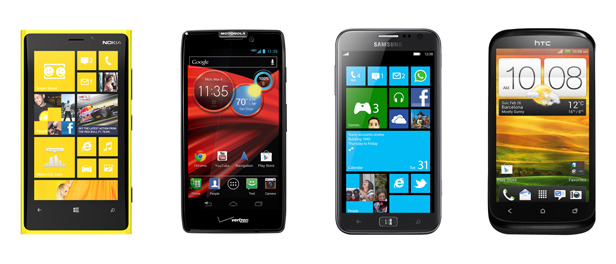The New Smartphone Incrementalism

If Wednesday’s announcements from Nokia and Motorola said anything about the next smartphone era, it is that the war started by Apple when it launched the iPhone in 2007 is turning into a lengthy trench battle of technological incrementalism.
Now it’s less about dramatic breakthroughs—such as Apple’s radical embrace of touch-screen-centrism, and its subsequent conceptual leap of opening up devices to app developers—and more about gaining marketing buzz to get consumers zeroing in on marginal advantages: a better camera here, a little longer battery life there.
“Although the feature changes are more incremental than they’ve been in the past, that’s normal in a maturing product category—especially when everyone is fixated on copying Apple’s form factor, a big mistake in my opinion,” says Michael Mace, a former product planning vice president at Palm and a former marketing executive at Apple. “When the features become more incremental, users generally focus on smaller feature differences.”
As they gear up for the holiday sales season, most major manufacturers have already announced (or are about to announce) new products in a year that is expected to see total shipments of some 700 million smartphones, according to CCS Insight, an analyst firm in London. They are generally full of features that seemed remarkable just a year or two ago, such as far sharper screens and voice-based assistants.
Wednesday saw two showy sendoffs in Manhattan four hours apart: first Nokia and Microsoft announced the new Lumia 920 and 820 with the new Windows 8 operating system (see “New Smartphones May Be Nokia’s Last Stand”). The Nokia products introduced wireless charging pads and improved cameras.
Then Motorola Mobility, now a unit of Google, announced three versions of its new Razr phone (see “Motorola Shows Off First Smartphones Under Google”), with advances that included longer battery lives and faster performance. In what has become the customary garish fashion, Motorola dressed up the event with an Australian rock trio beforehand and free alcohol afterward. A week earlier, global market leader Samsung announced its own Windows 8 phone, the Ativ S.
This coming Wednesday, Apple is expected to announce its new iPhone, the iPhone5. HTC is also expected to announce new products soon.
The others “preannounced, clearly, so they’d be on the minds of people ahead of the Apple announcement,” Mace says.
The timing also suggests that Motorola and Google take Nokia and Microsoft seriously, despite relatively slow sales for Nokia Windows devices so far. “By doing it on the same day as Nokia they sort of endorse Nokia/Microsoft as a competitor, and furthermore they announced a product that, in terms of features, sounds less impressive than the Nokia product,” Mace says. “Google did Microsoft and Nokia a bit of a favor, and I’m surprised.”
He adds: “The downside for Nokia is that Apple will be able to think about Nokia’s messages and respond to them. But for Nokia, even being attacked by Apple in public would be a win right now, because that would legitimize them as a major competitor to Apple.”
The merits of the smartphones themselves, marginal or otherwise, is only part of the equation. Without a sales push at the point of sale, the products can’t thrive, says Shaun Collins, head of CCS Insight and a former Motorola executive. “The success of these phones will depend on more than just the devices themselves. Support from network operators and retailers will be vital,” he says.
Nokia—which has not announced sales dates or prices yet—faces a particularly tough job, Collins adds. “To change the current preference for Apple and Android phones, Nokia and Microsoft will have to spend eye-watering sums on marketing and offer the new phones at aggressively low prices,” he says. “Success will rely on getting people to switch from Apple and Android, but it’ll be a huge challenge to get this message across.”
For Apple, the main job at this point—to maintain its position as the world’s most valuable company by market value—is not to let anybody see them sweat. “Announce a cool product, ship it in volume right away, and don’t spend much time talking about Google and no time at all talking about Microsoft/Nokia,” Mace says.
Whatever the advantages of the phones, Apple’s advantage will be hard to shake thanks to its loyal developer community developing new applications, says Chuck Goldman, founder of Apperian, an enterprise mobile app management company in Boston. The new phones are “exciting for the marketplace, but I don’t see them moving the needle or overtaking Apple in the near future,” he says. “The rock solid iOS ecosystem, overwhelming number of apps and passionate developers are going to keep Apple in a leadership position.”
Keep Reading
Most Popular
Large language models can do jaw-dropping things. But nobody knows exactly why.
And that's a problem. Figuring it out is one of the biggest scientific puzzles of our time and a crucial step towards controlling more powerful future models.
The problem with plug-in hybrids? Their drivers.
Plug-in hybrids are often sold as a transition to EVs, but new data from Europe shows we’re still underestimating the emissions they produce.
Google DeepMind’s new generative model makes Super Mario–like games from scratch
Genie learns how to control games by watching hours and hours of video. It could help train next-gen robots too.
How scientists traced a mysterious covid case back to six toilets
When wastewater surveillance turns into a hunt for a single infected individual, the ethics get tricky.
Stay connected
Get the latest updates from
MIT Technology Review
Discover special offers, top stories, upcoming events, and more.